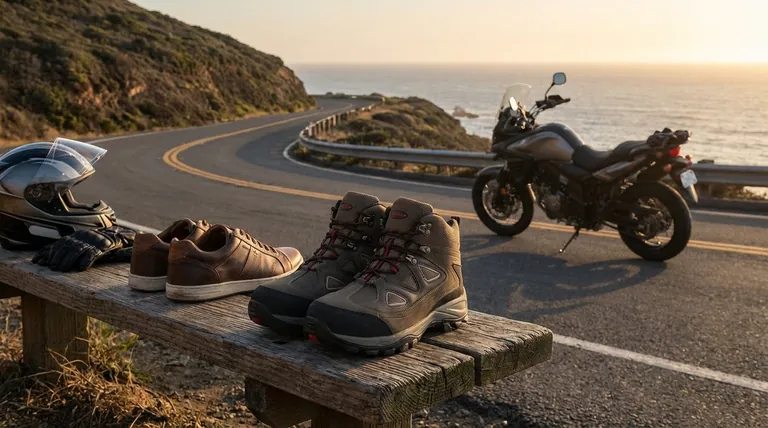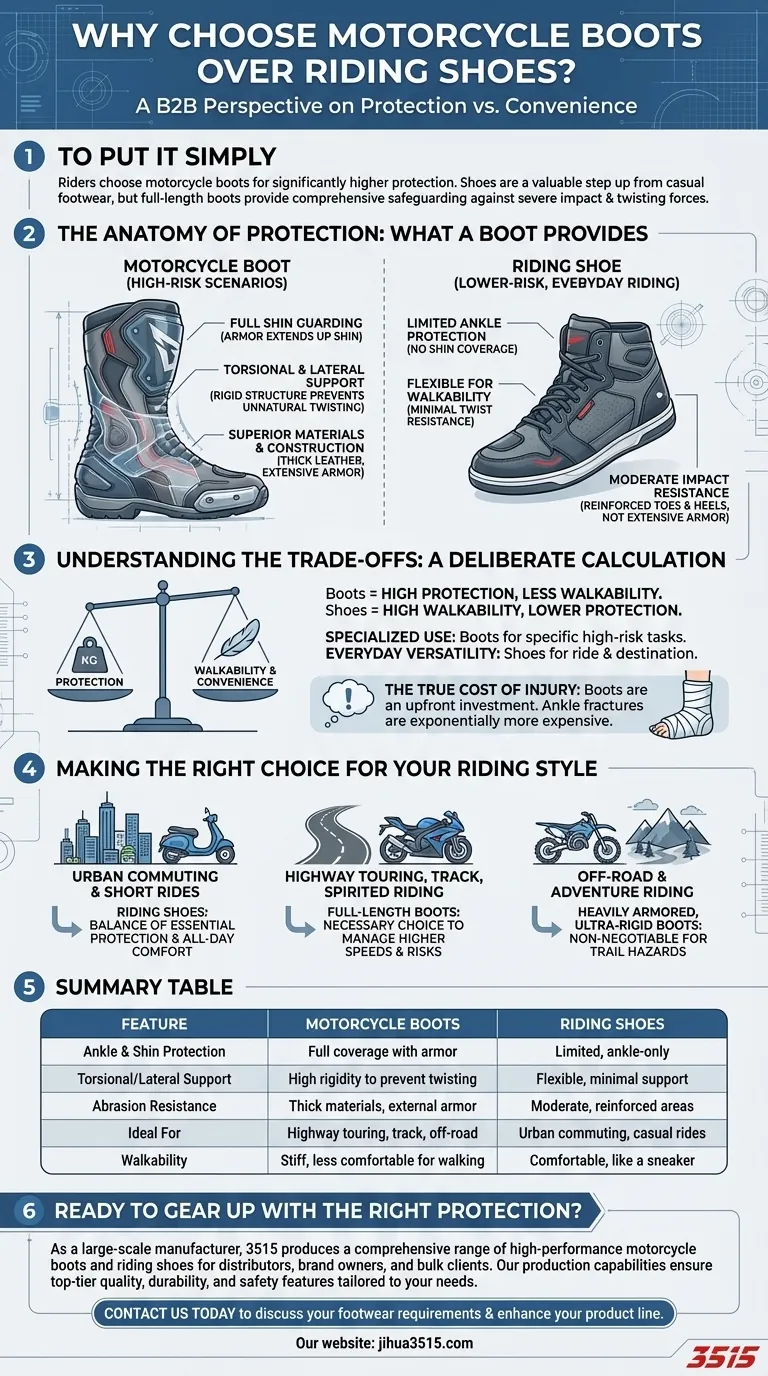To put it simply, a rider chooses motorcycle boots over riding shoes for a significantly higher level of protection. While riding shoes offer a valuable step up from casual footwear, full-length boots provide comprehensive safeguarding against the most severe impact and twisting forces common in a crash.
The decision between boots and shoes is not about which is "better," but about accurately matching your protective equipment to the level of risk you anticipate. Boots are specialized tools designed for higher-risk scenarios, while shoes are a compromise favoring convenience for lower-risk, everyday riding.

The Anatomy of Protection: What a Boot Provides
A true motorcycle boot is engineered with a singular focus on mitigating injury during a motorcycle accident. This is achieved through structural features that riding shoes simply cannot accommodate.
Beyond the Ankle: Full Shin Guarding
The most obvious difference is height. A full-length boot extends coverage up the shin, incorporating armor to protect against direct impacts from road debris or the motorcycle itself during a crash.
This area is highly vulnerable and completely exposed when wearing a riding shoe.
Resisting Twists: Torsional and Lateral Support
This is the most critical and least understood feature. Torsional support prevents the boot—and your ankle inside it—from twisting unnaturally. Lateral support prevents side-to-side hyper-extension.
Imagine your foot being planted on the pavement while your body is still moving. A riding shoe will flex and allow your ankle to break. A rigid boot is designed to resist these forces, dramatically reducing the risk of complex fractures and ligament damage.
Superior Materials and Construction
Motorcycle boots are typically constructed from thicker, more robust materials with extensive external armor. This provides superior resistance to abrasion during a long slide and better dissipates impact energy.
Specialized boots, like those for track or off-road riding, often feature advanced external hinge systems that allow for controlled forward-and-back movement while preventing dangerous lateral or twisting motion.
The Compromise of the Riding Shoe
Riding shoes exist to fill the gap between casual sneakers and dedicated boots. While they are an excellent choice for certain applications, it's vital to understand their inherent limitations.
Designed for Walking First
The primary benefit of a riding shoe is its comfort and style off the bike. They are designed to be walkable and blend in, making them ideal for commuting or running errands.
This focus on flexibility is, by definition, a compromise in structural rigidity and, therefore, protection against twisting forces.
Limited Impact and Abrasion Resistance
While riding shoes include valuable features like reinforced toe and heel boxes and protective ankle inserts, they generally lack the extensive hard armor and thick leather found on a full boot.
Their protection is designed for lower-speed urban scenarios, not high-speed incidents on a highway or racetrack.
Understanding the Trade-offs
Choosing your footwear is a deliberate calculation of risk versus convenience. There is no single right answer, only an informed choice for your specific needs.
Protection vs. Walkability
This is the central trade-off. A highly protective boot is often stiff, heavy, and awkward to walk in. A riding shoe feels almost like a normal sneaker once you're off the bike.
Specialized Use vs. Everyday Versatility
Boots are specialized equipment. You put them on to perform a specific, high-risk task and take them off afterward. Riding shoes are general-purpose gear, designed to be worn for the ride and the destination.
The True Cost of an Injury
While boots can be more expensive upfront, the cost of a complex ankle fracture—in terms of medical bills, lost work, and long-term mobility issues—is exponentially higher. The investment in protection should be weighed against the potential consequences of an accident.
Making the Right Choice for Your Riding Style
Your decision should be based on a realistic assessment of the type of riding you do most often.
- If your primary focus is urban commuting and short, casual rides: Riding shoes offer a fantastic balance of essential protection and all-day comfort.
- If your primary focus is highway touring, spirited canyon carving, or track days: Full-length boots are the necessary choice to manage the higher speeds and associated risks.
- If your primary focus is off-road or adventure riding: Heavily armored, ultra-rigid off-road boots are non-negotiable for protecting against the unique hazards of the trail.
Ultimately, choosing the right footwear is about making an honest assessment of your personal risk tolerance and riding habits.
Summary Table:
| Feature | Motorcycle Boots | Riding Shoes |
|---|---|---|
| Ankle & Shin Protection | Full coverage with armor | Limited, ankle-only |
| Torsional/Lateral Support | High rigidity to prevent twisting | Flexible, minimal support |
| Abrasion Resistance | Thick materials, external armor | Moderate, reinforced areas |
| Ideal For | Highway touring, track, off-road | Urban commuting, casual rides |
| Walkability | Stiff, less comfortable for walking | Comfortable, like a sneaker |
Ready to gear up with the right protection?
As a large-scale manufacturer, 3515 produces a comprehensive range of high-performance motorcycle boots and riding shoes for distributors, brand owners, and bulk clients. Our production capabilities ensure top-tier quality, durability, and safety features tailored to your needs.
Contact us today to discuss your footwear requirements and discover how we can enhance your product line with reliable, protective gear.
Visual Guide

Related Products
- Safety Footwear Wholesale Manufacturer for Custom OEM/ODM Production
- Premium Flame-Retardant Waterproof Safety Boots and Shoes
- Wholesale Safety Footwear Manufacturer for Bulk & Custom OEM Orders
- Customizable Anti-Smash Safety Boots for Wholesale & Private Label Manufacturing
- Premium Wholesale Waterproof Safety Boots High Performance Protection for Industrial Markets
People Also Ask
- What are OSHA approved shoes? Understanding the Correct Standards for Workplace Safety
- Is safety-toe as good as steel toe? Choose the Right Protection for Your Job
- Do snake bite boots work? Your Ultimate Guide to Effective Snake Bite Protection
- What do heavy duty boots do? Protect Your Feet in Demanding Work Environments
- What are the differences between steel toe, composite toe, and alloy toe Wellington boots? Choose the Right Safety Toe for Your Job



















